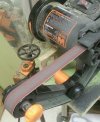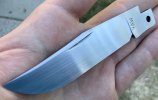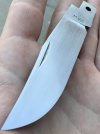Hey all.
Another quick question if you don’t mind.
I am looking to pick up a belt sander/stock removal setup. Of course I’d love to have one of those beauties that you guys that do this for a living or for a serious hobby have, but that’s WAY out of my budget. I’d like to pick up a belt sander that is good enough to let me try this and see if I enjoy it enough to put more time and money into it. It might end up that making a knife is just not for me. I want to try and see though.
I’ve been looking on Craigslist and OfferUp and such and found several possible choices. I like the Craftsman that has the tilting belt sander along with the disc sander too.
Can you all give me some suggestions on what would be a decent machine to look for that won’t cost very much but will still work pretty well? I’ll need it to have one of those adjustable shelf fixture too.
Any suggestions are appreciated.
thank you all again.
Another quick question if you don’t mind.
I am looking to pick up a belt sander/stock removal setup. Of course I’d love to have one of those beauties that you guys that do this for a living or for a serious hobby have, but that’s WAY out of my budget. I’d like to pick up a belt sander that is good enough to let me try this and see if I enjoy it enough to put more time and money into it. It might end up that making a knife is just not for me. I want to try and see though.
I’ve been looking on Craigslist and OfferUp and such and found several possible choices. I like the Craftsman that has the tilting belt sander along with the disc sander too.
Can you all give me some suggestions on what would be a decent machine to look for that won’t cost very much but will still work pretty well? I’ll need it to have one of those adjustable shelf fixture too.
Any suggestions are appreciated.
thank you all again.



